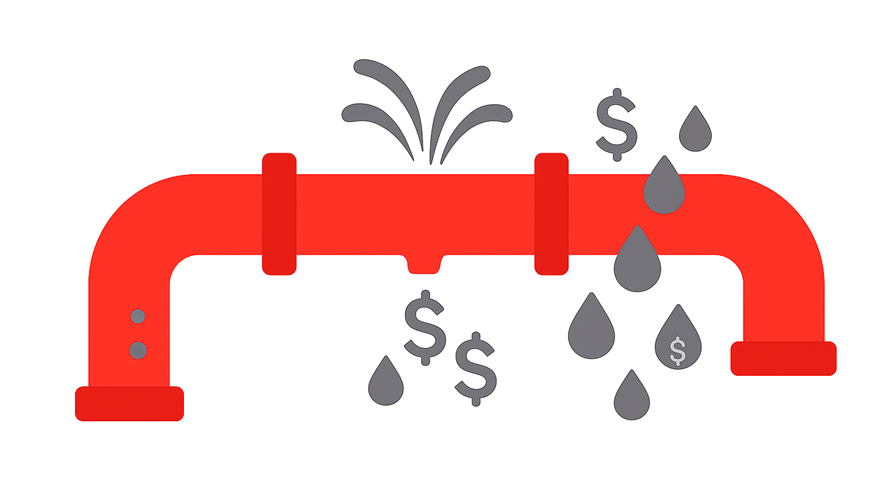Why Orchestration Debt Belongs in Your 2026 Marketing Plan

Summary
This blog explores orchestration debt in B2B marketing: what it is, how it slows execution, and why it belongs in your 2026 GTM plan. Learn to spot hidden inefficiencies, prevent revenue leakage, and build a roadmap to scale with less friction.
Every annual planning season, marketing teams feel the same push and pull. On one side: fresh ideas, new budgets, ambitious targets. On the other: the reality of messy systems, manual workarounds, and execution bottlenecks that threaten to slow everything down.
That second force is often invisible, but powerful. It’s called go-to-market (GTM) orchestration debt, also known as marketing orchestration debt. And if you don’t plan for it now, it will quietly compound all year, dragging down your ability to hit revenue goals.
For a primer on orchestration as a discipline, see Marketing Orchestration: What it is and Why it’s Important, and check out our FAQ on GTM Orchestration. In this post, we’ll go deeper — especially into the notion of debt within orchestration and how that plays out in real GTM systems.
What Is Orchestration Debt?
Orchestration debt is the cumulative burden of misaligned processes, fragile or incomplete workflows, disconnected systems, and inconsistent governance across your marketing and revenue engine.
It’s not a campaign problem; it’s a structural one. Think of it as the interest you pay on past shortcuts, half-baked integrations, or siloed workflows. Every new campaign or channel has to route through the same tangled web, making it slower and more error-prone to execute.
How it differs from other types of debt:
- Technical debt: shortcuts in code and tech stack integration that slow future development
- Operational debt: inefficient processes that pile up over time
- Campaign debt: unused content and creative assets; improper data management to optimize future campaigns
- Orchestration debt: the connective tissue itself—the way data, workflows, channels, and teams are supposed to flow together
For B2B organizations with long, multi-touch buyer journeys, orchestration debt is especially dangerous because it directly undermines both velocity (speed to market, speed to revenue) and consistency (coherent customer experience).
Where Orchestration Debt Comes From
- Scaling faster than your foundation can handle: Adding new regions, channels, or products before workflows are standardized
- Disconnected technology stacks: CRM, MAP, intent platforms, ABM tools, and analytics stitched together with brittle integrations
- Cross-functional misalignment: Sales, marketing, and CS building their own processes without shared orchestration standards
- One-off fixes and “duct tape” automations: Quick workarounds that solve today’s problem but create tomorrow’s fragility
- Zombie workflows and campaigns: Old nurture streams or triggers that are still active but unmanaged
- Weak governance: No defined orchestration owner, no cadence for cleanup, and no naming conventions or design standards
As we wrote in How to Tell When It’s Time to Improve Your Marketing Orchestration, you often don’t realize how much orchestration debt you’ve accumulated until simple campaigns take weeks longer than they should, or sales complains that handoffs are inconsistent.
The Real Cost of Carrying Debt
Like financial debt, orchestration debt accrues interest. The longer it goes unchecked, the harder and more expensive it is to address.
The costs include:
- Execution drag: Campaign launches take weeks longer than planned
- Revenue leakage: Leads drop out of handoff points or get routed incorrectly
- Wasted resources: Teams duplicate work or constantly troubleshoot broken systems
- Scaling fragility: Small cracks become major breaks when volume increases
- Burnout: Marketing ops and SDR teams spend more time firefighting than optimizing
- Customer frustration: Buyers experience inconsistent messaging, duplicate touches, or awkward silences
Orchestration debt often manifests as revenue leakage: the deals or pipeline you should have captured, but lost because workflows, data syncs, or handoffs broke down.
Beginning-of-Year Planning Through the Debt Lens
So how do you plan smarter annually? The key is to treat orchestration health as a first-class workstream in your annual planning cycle, not just a behind-the-scenes cleanup project.
1. Audit & Inventory
- Map your critical journeys (awareness > nurture > handoff > closed/won > renewal)
- Catalog the workflows, automations, and systems each journey depends on
- Interview internal stakeholders to surface known pain points: “Where do leads stall?”; “What’s manual that should be automated?”
- Score each debt hotspot by impact (revenue at risk, volume of records affected) and urgency
2. Define Your Target State
- Use orchestration maturity models to benchmark your current state: contact us at Heinz Marketing for a free consultation using our Marketing Orchestration Scorecard
- Decide what “healthy orchestration” looks like for your size and growth stage
- Set guiding principles: e.g., “no manual handoffs,” “single source of truth for accounts,” “shared orchestration governance.”
3. Balance Remediation vs. New Initiatives
It’s not about fixing everything before you move forward. Instead:
- Dedicate a “debt budget” (i.e., a fixed portion of ops resources or campaign calendar) to tackle orchestration debt
- Prioritize fixes that unlock velocity for the rest of your plan
- Sequence new initiatives so they don’t pile on top of fragile foundations
4. Build a Phased Roadmap
- Quick wins: prune unused workflows, align field mappings, standardize naming conventions
- Medium-term projects: refactor nurture flows, redesign lead routing logic
- Foundational work: unify data models, implement orchestration governance councils
Visualize the roadmap alongside new campaign launches so tradeoffs are explicit. For more on tying orchestration into fiscal planning, see Orchestrating Your Budget for Demand Gen Success: A Fiscal Year Planning Guide.
5. Establish Governance & Rituals
- Appoint an orchestration owner (Marketing Ops, RevOps, or a cross-functional council)
- Schedule quarterly “orchestration reviews” to update the backlog
- Define escalation paths and decision rights when orchestration tradeoffs arise
As we discuss in Marketing Orchestration Fails Without Communication, communication breakdowns are a major contributor to orchestration debt. Governance isn’t just about workflows — it’s also about the feedback loops and conversations that keep teams aligned.
6. Instrument the Right Metrics
Leading indicators:
- Workflow error rates
- Handoff latency (time between marketing to sales to CS)
- Campaign launch cycle time
Lagging indicators:
- Funnel conversion rates
- Revenue leakage identified in postmortems
- Time spent troubleshooting vs. innovating
Examples in Practice
Example 1: Misaligned Multi-Channel Nurture
A B2B company launches a coordinated nurture program: targeted ads, automated email sequences, and SDR follow-up cadences aimed at the same account list. On paper, it looks aligned. In execution, cracks in orchestration show up quickly:
- Suppression logic is inconsistent: A prospect who clicks an email still sees the same ads in LinkedIn and display, creating message fatigue.
- Channel engagement isn’t shared: SDRs have no visibility into ad impressions or clicks, so their outreach feels generic instead of contextually relevant.
- Messaging drifts: Email content emphasizes one pain point, ads highlight another, and SDRs default to their own scripts. Prospects experience a fractured story.
- Reporting is siloed: Marketing can’t see how email and ads influence SDR outcomes, so attribution is incomplete and optimization is guesswork.
The outcome is more than wasted ad dollars. Buyers feel over-touched or confused, SDRs feel disconnected from marketing, and leadership loses confidence in the “integrated campaign” approach.
Fix:
- Align suppression rules across email, advertising, and sales cadences so buyers don’t get bombarded
- Build a shared journey state object (or simple tracking field) that indicates where each account is in the nurture flow
- Integrate ad engagement data into CRM or sales engagement platforms so SDRs can tailor outreach based on context
- Create a campaign “orchestration playbook” that defines the narrative across channels, ensuring consistency
- Consolidate reporting into one dashboard showing how all three channels contribute to pipeline progression
Example 2: Sales Handoff Failures
A marketing campaign generates a healthy volume of MQLs, but once those leads are pushed into Salesforce, the cracks appear:
- Territory logic conflicts mean some leads don’t get assigned at all.
- Duplicate records route to multiple SDRs, causing confusion or wasted outreach.
- Lead status mismatches between marketing automation and CRM leave some prospects “stuck” in limbo.
- Reporting blind spots prevent marketing from seeing how many leads were actually followed up on, eroding trust between teams.
The downstream effect is bigger than just operational frustration. SDRs lose confidence in the system and start creating manual workarounds. Sales managers distrust marketing-supplied leads. Marketing loses visibility into pipeline attribution. Over time, this debt compounds into slower follow-up, lost opportunities, and finger-pointing between teams.
Fix:
- Refactor lead routing rules to simplify assignment logic and resolve conflicts
- Add error queues or “exception dashboards” that flag unassigned or duplicate leads in real time
- Automate reconciliation reports that highlight discrepancies between marketing automation and CRM
- Create a shared SLA between Marketing Ops and Sales Ops for handoff timing and data hygiene, ensuring every lead has an owner within a defined window
Pitfalls to Avoid
- Over-engineering too soon: Don’t build a “perfect” orchestration model that’s impossible to maintain — and also continuous optimization is our closest “perfection”.
- Treating remediation as one-and-done: Debt will re-accumulate without ongoing upkeep; growth requires scale, and scale requires optimization.
- Ignoring the human side: New processes without enablement just shift the burden when a culture of accountability is not fostered and upheld.
- Underestimating sponsorship: Without executive backing, orchestration fixes lose priority; that’s why understanding orchestration debt is fundamental to winning executive buy-in.
Conclusion: Start the Year by Reducing Drag
The most successful B2B marketing teams don’t just dream big at the beginning of the year — they plan realistically by acknowledging and tackling orchestration debt.
If you ignore it, debt compounds silently, draining resources and slowing velocity. If you address it intentionally, you create a cleaner runway for every campaign, every touchpoint, and every revenue team.
So as you finalize 2026 planning:
-
Run an orchestration audit
-
Dedicate a budget of time and attention to debt remediation
-
Define your target orchestration maturity
-
Balance fixes with growth bets
Doing this won’t just help you launch more — it will help you scale more, with less friction and more consistency. And that might be the single best growth lever you unlock this year. Contact us is you would like help defining your orchestration maturity and putting together a game plan to win over your executive team this planning season.






